Ingrid Bazin
IMT Mines Alès | #Water #Biosensors
[toggle title=”Find all her articles on I’MTech” state=”open”]
[/toggle]
IMT Mines Alès | #Water #Biosensors
[toggle title=”Find all her articles on I’MTech” state=”open”]
[/toggle]
IMT Nord Europe | #Polymers #CompositeMaterials #PlasticsProcessing #BiobasedMaterials #Recycling #AdvancedManufacturing
 Patricia Krawczak is Full Professor at IMT Nord Europe. She holds an Engineering degree (MEng./MSc.) with major in Plastics and Composites Technology from Mines Douai (1989), a PhD degree in Macromolecular Chemistry – Solid-state polymers (1993) and a post-doctoral qualification as Research Director in Physics (HDR, 1999) from University of Lille, and Légion d’Honneur national award. She has been the Director of the Polymers and Composites Technology & Mechanical Engineering (TPCIM) Department of IMT Nord Europe (formerly IMT Lille Douai) from 2000 to 2019. She gained deep experience in the field of plastics and composites engineering through numerous collaborations with industrial companies and participations in national and European industry-oriented projects. She authored over 380 journal or conference publications and book chapters, and is Associate Editor of Frontiers in Materials (Polymeric and Composite Materials section). Her current research interests focus on advanced processing/manufacturing technologies, physics and mechanics of polymers and polymer composites.
Patricia Krawczak is Full Professor at IMT Nord Europe. She holds an Engineering degree (MEng./MSc.) with major in Plastics and Composites Technology from Mines Douai (1989), a PhD degree in Macromolecular Chemistry – Solid-state polymers (1993) and a post-doctoral qualification as Research Director in Physics (HDR, 1999) from University of Lille, and Légion d’Honneur national award. She has been the Director of the Polymers and Composites Technology & Mechanical Engineering (TPCIM) Department of IMT Nord Europe (formerly IMT Lille Douai) from 2000 to 2019. She gained deep experience in the field of plastics and composites engineering through numerous collaborations with industrial companies and participations in national and European industry-oriented projects. She authored over 380 journal or conference publications and book chapters, and is Associate Editor of Frontiers in Materials (Polymeric and Composite Materials section). Her current research interests focus on advanced processing/manufacturing technologies, physics and mechanics of polymers and polymer composites.
[toggle title=”Find all her articles on I’MTech” state=”open”]
[/toggle]

ALICE’s detector is as big as a 5 floors high building. Credits: CERN.
ALICE. Behind this poetic acronym full of fantasy, lies one of the four experiments of the Large Hadron Collider (LHC). Although the Swiss particle collider of the Cern is famous for hosting the discovery of the Higgs boson, other researches are carried out on the topic of fundamental matter. ALICE, which stands for A Large Ion Collider Experiment, is among them: its mission is the study and characterization of quark-gluon plasma. “It is a deconfined state of matter, in which interactions binding the components of protons and neutrons do not exist anymore” explains Ginés Martinez, member of a research team in Subatech — a collaboration between Mines Nantes, CNRS and Université de Nantes — full member of the ALICE collaboration.
Less known than ATLAS and CMS, the LHC experiments that have led to to the 2013 Nobel prize, ALICE has nothing to envy to its too big sisters though: 26 meters long, 16 meters high and weighing 10,000 tons, its characteristics are in the superlative standards of the LHC. Although the particle collider has started its “Run 2” last March, with proton collisions reaching now 13 TeV*, ALICE main mission has truly started only last month.
Back in 2010: first collisions between protons — hydrogen atoms without electrons — are happening at the LHC. ATLAS, CMS, and even ALICE are looking upon them with their huge sensors. But ALICE is backstage: collisions between protons are not energetic enough to produce a quark-gluon plasma. ALICE knows it for RHIC, a smaller and older collider based in Long Island, USA, has already demonstrated this fact. ALICE has to wait for other collisions: those between lead ions — lead atoms also without electrons. These ones will occur the same year, several months after first proton-proton collisions.
Unfortunately, each time the nature of the collisions changes, “every optical tool in the LHC has to be recalibrate” describes Ginés Martinez. The researcher then explains that “lead-lead collisions only take place one month each year” before adding that “proton-proton collisions keep the LHC busy 90 % of the time”. For 2015, first lead-lead collisions have been produced on November 17th. The time during which ALICE reveals all its potential is then… Right now. Up till mid-December.
ALICE staff members during the launch of the LHC “Run 2”. Credits: Laurent Egli / CERN.
To form this plasma, lead ions are accelerated in the 27 km long ring of the LHC, up to a speed close to the light speed. When they collide, lead ions release a tremendous amount of energy. Protons and neutrons forming the atom nucleus melt in a drop of plasma, and release quarks and gluons that compose them. These particles are fundamental components of matter, just like electrons, meaning they can’t be subdivided into smaller building blocks. The collision is so intense that “matter heats up to dreadful temperatures, several trillion degrees” says Ginés Martinez. For comparison, Sun inner centre would appear like a winter chill with its 15 million degrees.
With this drop of deconfined matter, of quark-gluon plasma, starts the mission of ALICE. For the collision point is under vacuum, the state of the drop is temporary. Under vacuum, matter tends to occupy maximum space. The plasma drop expands as much as it can, and then disappears. The phenomenon is similar to a water drop that would be under vacuum: H2O molecules would spread apart till they are so far away from each other than it becomes a gas, and not a liquid anymore. Quark-gluon plasma acts this way. The sensors of ALICE watch every particle spreading from the collision point and measure their trajectories. “Especially, we pay attention to muons coming from particles formed by heavy quarks, like beauty and charmed quarks”.
This wide range of different particles is expulsed in many different trajectories. As they are spread in all the directions, they pass through thin plates of silicon placed in layers all around the point of collision. Every time a particle crosses a silicon layer, an electric signal is produced. “We can measure very precisely the trajectory of each emitted particle” explains Ginés Martinez. These data are crucial, as they allow scientists to determine the mass of the particles, their speed and their energy. With such information, physicists can better understand how matter is organized.

3D visualization of ejected particles trajectories after a lead-lead collision. Credits: CERN.
Once particles have been ejected, a phenomenon called “hadronization” occurs. As the drop of plasma is under vacuum, its temperature decrease and it loses energy. Quarks and gluons then bind together to form thousands of species of hadrons — among which protons and neutrons. This cooling is close to what happened to matter when the universe quickly expanded during the big bang. Study of the hadronization phenomenon gives insights to researchers about how atoms formed at the birth of the universe.
Each year, the ALICE team composed of 1,500 researchers makes another step towards the understanding of the matter. To increase the sensibility of the sensors, Subatech works with the Research Institute on Fundamental Laws (Irfu) of the CEA and the Cern to develop a new generation of sensors using the MAPS technology. The purpose is to be able to track 100,000 collisions by 2020, against 10,000 now. Such an increasing of ALICE capacity should allow more precision in the observations, and better monitor trajectories of the particles.
*TeV stands for Teraelectronvolt, which is 1012 electronvolts (eV). The electronvolt is a unit of energy adapted to the scale of nucleus. The energy of the nucleon of a lead atom is 5 TeV high during the collision. A proton can reach 13 TeV thanks to a higher charge over mass ratio. Such energies can only be produced at the LHC currently.
**MAPS stands for Monolithic Active Pixel Sensors, which are sensors inspired by a technology of medical imagery to detect visible light. MAPS sensors fully integrate electronics and detection volume in the same silicon wafer.
[box type=”shadow” align=”aligncenter” class=”” width=”95%”]
Fundamental particles are the smallest components of matter. These entities can not be subdivided. For instance, electrons belong to this category. Quarks and gluons too: together, they form bigger particles called “hadrons” like protons and neutrons that form a nucleus when they bind. Thus, hadrons are not fundamental particles. Each fundamental particle has its own properties, and are therefore more or less sensitive to physical elementary interactions. Properties of quarks make them sensitive to the strong nuclear interaction, which confines hadrons. This strong interaction is carried by other fundamental particles: gluons, just like electromagnetic force is carried by photons.

The standard model in a table. Credits: Dopplerlover.
[/box]
Think Tank Futur numérique | #imagination #DigitalTransformation
[toggle title=”Learn more” state=”open”]
[/toggle]
Discover her website
IMT Atlantique | #DarkMatter #WIMP #Subatech
[toggle title=”Find all his articles on I’MTech” state=”open”]
[/toggle]
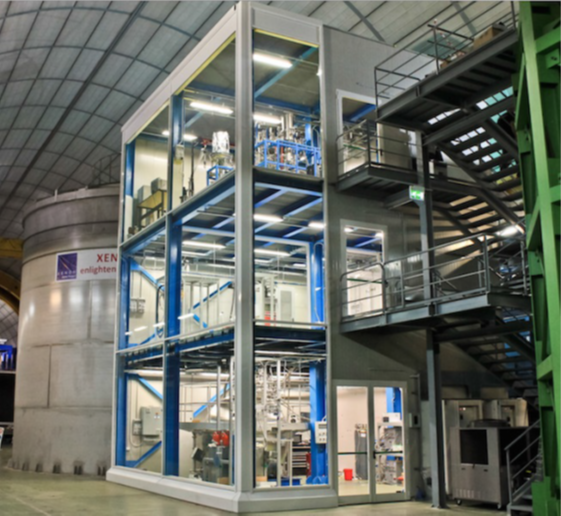
XENON1T is the largest dark matter detector built to date
What is dark matter? How can we observe it? Are we even certain it exists? Many questions have fueled this scientific controversy for decades. According to Dominique Thers, the answer to the third question is absolutely clear: “The observation of certain phenomena in our universe leaves no doubt that dark matter does exist”. This comes as no surprise: since 2009, this researcher from the Subatech laboratory — under the supervision of Mines Nantes, the University of Nantes and the CNRS — has been hunting for dark matter. The first clues appeared in the 1930s, when a Swiss astronomer named Fritz Zwicky measured the velocity of seven galaxies in the Coma Berenices constellation. The data collected presented a problem; if the observed velocities were correct, then the galaxies’ masses would have to be greater than that of the visible matter that composed them. He therefore hypothesized that the galaxies must consist of an invisible mass as well: dark matter. Almost one century later, astronomers have accumulated more evidence, in particular via the Planck satellite, enabling them to reinforce this idea which has since become a certainty. Yet these observations are all indirect, since they involve determining the presence of this enigmatic matter through phenomena that do not truly reveal it. So, in order to reveal dark matter once and for all, the XENON research program decided to develop an experimental device on an unprecedented scale called XENON1T, which is the result of a several years of collaboration between 21 international teams, bringing together over 120 researchers, including Dominique Thers and his colleagues from Subatech. It was inaugurated on November 11, in the heart of Italy.
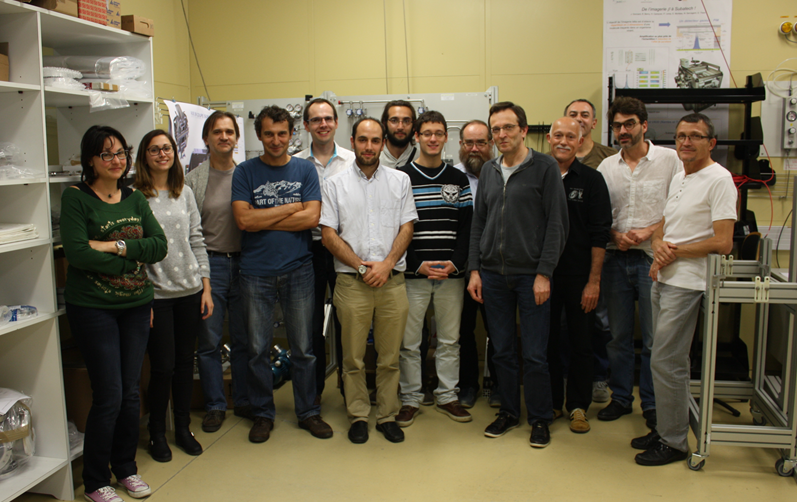
The Xenon team at the Subatech laboratory, one of the 21 teams working to detect dark matter on the XENON program.
The XENON program works on the premise that out of all the current hypotheses on the nature of dark matter, the most probable concerns WIMPs — an acronym for weakly interacting massive particles. WIMPs are thought to be particles of matter, but different from baryons, which include protons and neutrons, which are the building blocks for atomic nuclei. Unlike baryons, WIMPs are thought to react very weakly to normal matter due to their extremely small interaction surface area, but are believed to have a very large mass, which explains why they cannot be observed, while solving the mystery of the invisible mass in the universe. However, little interaction does not mean no interaction. This nuance is the starting point for researchers. Because although it is very unlikely, the probability of a WIMP coming into contact with the nucleus of an atom, or an electron orbiting around the atom, does indeed exist. The challenge is therefore to make sure this collision takes place while the scientists are watching. Or rather, when their instruments are watching, since the detection of this phenomenon requires very specialized tools.
XENON1T is in fact an enormous chamber filled with one metric tonne of the chemical element xenon, maintained in a liquid state at a temperature around -100 °C. Above this liquid there is a thin layer of xenon in a gaseous state. The key is for a WIMP to interact with the xenon inside the chamber. “When a dark matter particle collides with the xenon, it dimerizes due to the energy created by the collision,” explains Dominique Thers. In other words: two isolated xenon atoms come together to form a dixenon molecule. Yet this state is temporary, because it is unstable. The molecule quickly separates again, forming two isolated and inert xenon atoms. But since energy was consumed to link the two atoms, the energy is emitted when they separate — “nothing is lost,” to quote Antoine Lavoisier. And this energy is emitted in the form of a photon. Or, in other words, light. “This light signal, called ‘scintillation’, is detected by the instruments located above and below the liquid xenon chamber, and is the first signal we record,” explains. But this is not all: the impact of the WIMP and atom colliding causes the xenon nucleus and electrons to move backwards, and as they slow down, they ionize the xenon in their orbit. Although an electron that has been removed usually returns to its original nucleus, the researchers prevent it from doing so by applying an electrical field to the device. The electrons are therefore forced to follow this path and rise to the top of the chamber, where they enter the gaseous phase, at the same time releasing a second signal, called an “ionization” signal. According to Dominique Thers, “the two signals allow us to very precisely determine the nature of the particle that caused the collision.”

Diagram explaining the XENON1T experiment
The problem is that WIMPs face serious competition. Many different particles produced by cosmic rays bombard the earth each day and interact with ordinary matter, and much more frequently than WIMPs. To protect themselves from these disruptive particles, the XENON collaboration decided to bury their project 1,400 meters below the Gran Sasso mountain in the Apennines, in the largest underground laboratory in the world: the Gran Sasso National Laboratory (LNGS). The only particles that can pass through the rock to the laboratory are particles that hardly interact at all with ordinary matter, such as dark matter particles.
Despite these precautions, unwanted residual signals remain, referred to as “noise”. It was for this reason that researchers decided to establish a procedure using a tonne of liquid xenon, in order to limit this “noise”. “The first prototype, XENON10, contained only 10 kg of xenon, then in 2009 we increased to 100 kg with XENON100,” Dominique Thers recalls. “As the volume increases, we are more likely to detect a collision,” he adds. The detector’s upgrade to a volume equivalent to a mass of one tonne will make the results much more precise, making it the most advanced detector in the world. XENON1T, the successor to XENON100 and XENON10, will therefore “improve the accuracy of the observations a hundredfold compared to the current limitations,” explains the Subatech team coordinator. The researchers are therefore optimistic about finally detecting the long-awaited dark matter particle: “We hope to have results in the first months of the detector’s exposure,” says Dominique Thers. Before now, physicists had always advanced by eliminating hypotheses and hoping they would reach only one possibility. The observation of an interaction with xenon would represent considerable progress, since it would enable the identification of the particles that constitute this matter that remains so mysterious, despite it being five times more abundant in our universe than ordinary matter. And if XENON1T is unable to achieve its goal, the researchers in the underground laboratory already have plans to upgrade to a larger size. In 2018, XENON1T will become XENONnT, multiplying its weight in liquid xenon by five.

Access tunnel for the national Gran Sasso laboratory
In science, discoveries sometimes come about because of who you meet. This was the case of Róisín Owens and her husband George Malliaras, when they entered this new field of research called bioelectronics. “I was a biologist specializing in infectious diseases, and he was an expert in physics and materials science” Róisín explains. “He would talk to me about his new technology, and I thought about how it could be applied to biology. This was how we came up with this new project together, combining biology and electronics”. The project became a reality in 2009 with the creation of the Bioelectronics department at the Provence Microelectronics Center of Mines Saint-Étienne, in Gardanne. While one part of the department, with the team led by George Malliaras, focused on neurosciences or, more recently, on electronics in fabrics through research led by Esma Ismailova, Róisín Owens set up the IONOSENSE program (see insert), designed to create a new in vitro diagnostic device.
Róisín and her team have centered their research on technology known as organic electronics. In contrast to traditional electronics, based on rigid materials like silicon and copper, organic electronics uses flexible polymers that offer a better interface with biology. “Furthermore, these materials are transparent, allowing direct observation of the cells in the device” notes the Irish researcher. These polymer structures are used in devices called “organic transistors” which have enhanced signal transduction and are thus extremely sensitive. “The cells between the electrodes of the polymer and the transistor act as a resistor by limiting ionic transfer, which is something that can be measured” she explains. “If the cells are in poor condition, for example if they are affected by a toxin, they have a lower resistance. In this way we can measure the state of health of the cell culture in real time”.
[box type=”shadow” align=”” class=”” width=””]IONOSENSE: a double grant-winning program
Róisín Owens’ work at Mines Saint-Etienne is closely linked to the IONOSENSE project, or Exploitation of Organic Electrochemical Transistors for Biological Ion sensing. Launched in 2011 thanks to a Starting Grant from the European Research Council (ERC) of €1.5 million, this program led to the development of the first bioelectronics devices. “We have shown that thanks to these devices, we can detect the presence of different pathogens: viruses, toxins and bacteria” explains Róisín. Working at the same time on other research themes (microfluidics, biofilms, etc.), the IONOSENSE program progressed towards its scheduled completion in 2015, but this was before another prestigious grant from the ERC was obtained at the end of 2014: the Proof of Concept grant for an additional year, for a sum of €150,000 which will be spent working on the potential commercialization of the technique. For Róisín these grants are not just good financial support. “It’s particularly gratifying from a personal point of view,” she continues. “It has built my career and allowed me to develop my ideas”.[/box]
The validity of the results produced by these small devices had to be proved over the course of many months, and to this end the transparent nature of the polymers was of valuable assistance, allowing electronic measurements to be compared with direct observations. Róisín and her team then wanted to go one step further by exploring the possibilities of this new system in other fields, in particular no longer studying whole cells but focusing on lipid bilayers with integrated proteins, allowing observation of the interactions between the pathogens and the cell wall. Above all, however, the biologist is transitioning from the use of glass surfaces in favor of 3D structures. “In toxicology we know that there is a big difference between cells in vivo and cultures on two-dimensional substrates”. The team produces polymer conductors that build three-dimensional structures, onto which the cells are placed, and where the cell properties can still be studied in real time.
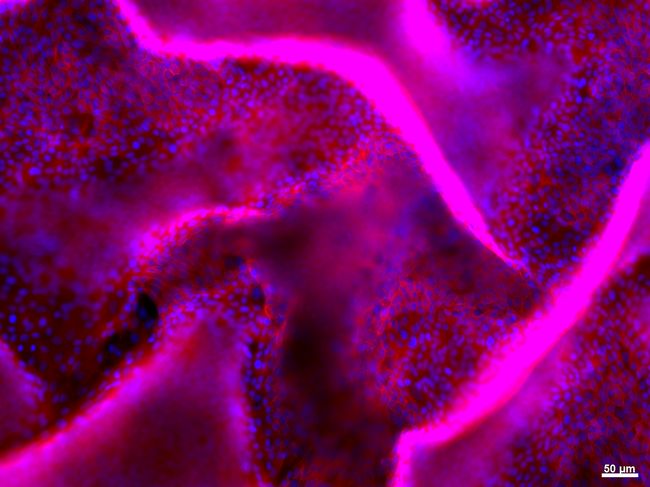
View of the detachement of a layer of kidney epithelial cells in a 3D model using fluorescence
An in vitro kidney model is under development, with a structure that also incorporates microfluidics. “In the kidney there is blood and urine and between the two are the epithelial and endothelial cells” Róisín Owens tells us. “In order to obtain a realistic cell model for the toxicology of the kidney, we need to include these two components”. The team produced a device containing 12 wells, each made up of a transistor, a fluidic system representing the urine, a membrane with epithelial cells on one side and endothelial cells on the other, and a second fluidic for the blood. “We maintain the transparency so that biologists can observe the cells, as well as electronics for measuring cell conductivity, but we now also have microfluidics, which allows us to measure the presence of biomarkers secreted by the cells in the tubes” the biologist continues.
Although the results are particularly promising, there is still a long way to go before these devices can be used in laboratories. “We would like to improve our technique with a view to commercial production, but first we need even more results to persuade people of the effectiveness of our system” Róisín Owens went on. “In addition to toxicology there is the fundamental research aspect: using optics and electronics at the same time could enable us to better understand cell movement and adhesion mechanisms, which are of particular interest to oncologists”. For the pharmaceutical industry this new process developed in the Provence Microelectronics Center also offers very interesting advantages. “Bringing out a new drug can cost more than a billion euros and take 12 years to develop, but 90% of these drugs don’t have the desired effect on human beings” she emphasizes. “This is due to the fact that these tests are carried out on animals, which are very different to humans: we therefore need to improve in vitro studies on human cells, with more predictive models that limit the number of false positives.” Róisín believes it will take just under ten years for her system to be commonly used in laboratories. In the meantime, she is already thinking of setting up a company to develop specific combinations for a particular application, on demand. The history of bioelectronics has only just begun.
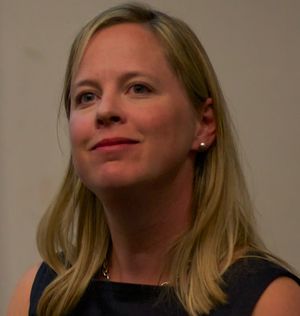 Róisín Owens’ career reflects her multilingual background: she speaks English, Gaelic, French, German and Greek. Culminating her studies in biochemistry in France, Ireland, she completed a PhD in England on proteins involved in infectious diseases, before taking off for the USA for her first postgraduate research at Cornell University, where she studied tuberculosis. In 2005, Róisín took time out from fundamental research and joined a New York start-up in order to develop technologies to improve the detection of pathogens. “At the time I wanted to go into something that was more applied”, she explained, but that was before realizing, two years later, that “[her] heart was in academic research”. She returned to Cornell University for two years for another postgraduate research project in an engineering department. “My husband is Greek and I’m Irish: after eight years in the USA we wanted to return to Europe”, Róisín recalls. In 2009 they both joined Mines Saint-Etienne, where their arrival led to the creation of the Bioelectronics department in the Provence Microelectronics Center. Today, the center is made up of around 30 people.
Róisín Owens’ career reflects her multilingual background: she speaks English, Gaelic, French, German and Greek. Culminating her studies in biochemistry in France, Ireland, she completed a PhD in England on proteins involved in infectious diseases, before taking off for the USA for her first postgraduate research at Cornell University, where she studied tuberculosis. In 2005, Róisín took time out from fundamental research and joined a New York start-up in order to develop technologies to improve the detection of pathogens. “At the time I wanted to go into something that was more applied”, she explained, but that was before realizing, two years later, that “[her] heart was in academic research”. She returned to Cornell University for two years for another postgraduate research project in an engineering department. “My husband is Greek and I’m Irish: after eight years in the USA we wanted to return to Europe”, Róisín recalls. In 2009 they both joined Mines Saint-Etienne, where their arrival led to the creation of the Bioelectronics department in the Provence Microelectronics Center. Today, the center is made up of around 30 people.In his summing-up of the Franco-German conference on “accelerating the digital transformation of our economies”, Emmanuel Macron spoke on behalf of both himself and his German counterpart as he announced the creation of the German-French Academy for Industry of the Future, led by Institut Mines-Télécom and TUM. In their concluding speeches, French president François Hollande and German chancellor Angela Merkel both expressed their satisfaction with the foundation of this academy and their aspirations for its future.
The academy has a threefold objective in terms of research and training for industry of the future:
More broadly speaking, the Academy will have the remit of conducting forward-thinking discussions and research on the place of humans in the digital and industrial transitions, and of overseeing the emergence of new paradigms for the industry of the future.
Founded and led by Institut Mines-Télécom and Technische Universität München, both of whom are deeply involved in themes with strong links to industry of the future and corporate partnerships, the Academy will ultimately have a federating role with respect to partners of the alliance, such as Arts et Métiers ParisTech, other French academic partners, German universities of excellence, and the Fraunhofer Institutes.
The number of water pollutants is rising, including for example heavy metals, pesticides and preservatives. More than 800 substances are listed as being potentially harmful, 43 of which are regulated in France. The European Water Framework Directive of 20 October 2000, transcribed in France by the Law of 21 April 2004, aims to restore surface water and groundwater to good chemical and ecological condition by 2015, and put a stop to the discharge of certain dangerous substances – the 50 most urgent to eradicate – by 2020. The Laboratory for environmental industrial engineering (LGEI) at Mines Alès, and in particular the ESAH (Water, Anthropogenic Systems and Hydro Systems) team, works on diagnosis, measurement and analysis of environmental pollutants by developing biodetection tools (bioreceptors and biosensors). The ESAH team is principally made up of analytical chemists and it is strongly involved in the water competitive cluster in Montpellier as well as in the Montpellier Institute for Water and the Environment. “Our quality of life depends a lot on our environment” Ingrid Bazin reminds us, “and our initial objective is to improve the quality of our water-based ecosystems, as there are direct consequences on our level of health”. Herbicides are endocrine disruptors and have a direct impact on our hormone system, which is the cause of the famous feminization process in animal populations, notably among fish, which leads to an imbalance in the ecosystem and potentially catastrophic long term consequences for biodiversity and our health.

Field kit for detecting environmental pollutant
The ESAH team’s research is applied. “We work directly with water industry players such as Veolia and BRL (a construction company in Bas-Rhône and Languedoc) with a view to meeting the challenges facing them in the detection of water pollutants” the researcher explains. While efficient and regulated physico-chemical analysis tools are already available, the aim is now to demonstrate the benefits of developing biodetection tools in the environmental sector. Two major requirements are apparent: evaluating the overall harmfulness i.e. the effects of the pollutants in water on humans and the ecosystem, and detecting some molecules that present a challenge for treatment. This is the case, for example, of glyphosate and its metabolite, AMPA. “Glyphosate is not the most harmful herbicide found in the environment, but it is the most common because it is still used by a large number of people. Industrial firms are obliged to monitor it, particularly in sectors that produce drinking water which must not exceed a concentration of 0.1 µg/l” says Ingrid Bazin.
The aim is not to instantly detect pollutants like atrazine or hydrocarbons, since analytical chemistry already does this very well, but to optimize monitoring of the water cycle using biodetection tools that are simple to use, robust and inexpensive. The biodetection test must also be sensitive enough. A biological recognition element (i.e. a bioreceptor) with a strong affinity with the molecule in question is required to achieve this. Glyphosate and its metabolite, AMPA, are particularly small molecules for which “standard” detection using enzymatic biodereceptors, antibodies or small DNA fragments is difficult. “My idea is to use peptides of 6 to 15 amino acids, or even small proteins of 80 to 100 amino acids as bioreceptors in order to detect small molecules for which it is difficult to develop an antibody” explains Ingrid Bazin. In 2014 the idea won the “Researchers of the future” grant awarded by the Languedoc-Roussillon region, destined to support projects of excellence by young researchers (under 38 years). The prize money has allowed funding on the subject for the ESAH team’s research work for a year and a half, and notably testing the efficiency of detection of small molecules using a peptide sequence developed in the laboratory (the peptide or small protein that offers the best capacity for binding to glyphosate molecules).
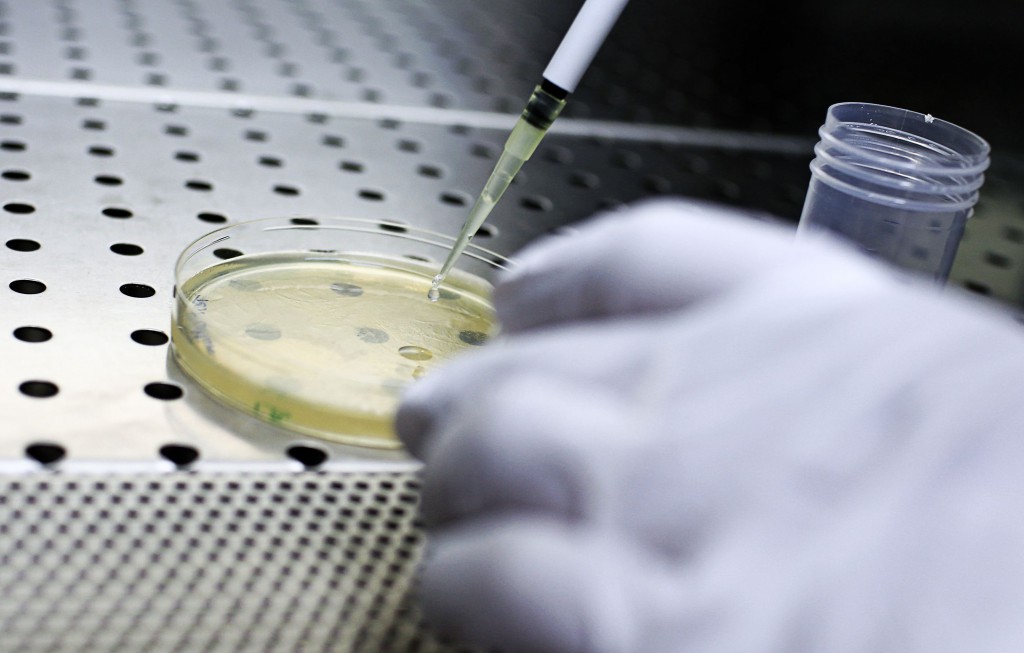
Cultivating bacteria in a petri dish of agar-agar
The next stage will consist in developing a rapid test that can be used on the ground, in the form of a test strip that lights up when it comes into contact with glyphosate and AMPA. Then, in time, “all in one” biosensors will be designed to enable the immediate assessment of the concentration of herbicides – available online, what is more. Additionally, the ESAH team is currently a partner of an ANR (French National Research Agency) project Combitox, that is managed by the CEA Cadarache (Atomic Energy Commission). This aim of this R&D project, due to finish at the end of 2015, is to develop an online multi-parameter instrument for continual biological measurement of three types of water pollutant: fecal bacteria, heavy metals and environmental toxins, which are what Ingrid Bazin and her team are interested in. “The innovative feature here is the creation of a biological recognition device: the peptide sequence, which will be perfect for detecting small molecules. It is a real challenge, even though the idea is not a new one, since the design and development of a biosensor is a very lengthy process and requires multiple laboratory and field trials” the researcher concludes. The final aim is to improve water quality and the quality of life of consumers.

Ingrid Bazin started her career in the biomedical sector in the Paris region. After finishing her preparatory studies she entered the University of Versailles in 1996 and then Pierre and Marie Curie University (Paris 6) in 1999, where she studied for a postgraduate advanced diploma in the Biology of Aging. She entered R&D in genetic engineering, researching new drugs to fight cancer and, as one thing led to another, she was drawn into the environmental sector, but this time in the south of France where she studied for a PhD in molecular biology and plant physiology at the CEA Cadarache (Atomic Energy Commission). “My work entailed studying the genes that lead to the accumulation of heavy metals in plants, in order to design tools for removing pollution from soils” she explains.
After postgraduate research at ISTMT (Institute of the Science and Technology of Medicine of Toulouse) and having participated in the start-up of the Grenoble-based company Smartox, which specializes in the synthesis of peptides for therapeutic uses, she joined Mines Alès in 2009 as a Research Professor and in 2015 received her Accreditation to Lead Research (HDR). Working in the Laboratory for environmental industrial engineering (LGEI) in the Water, Anthropogenic Systems and Hydro Systems (ESAH) team, Ingrid Bazin applies her knowledge as a biologist to the development of new tools for biodetection of environmental pollutants.
Four years after its launch, the partnership between France Brevets and Institut Mines-Télécom continues. An initial collaboration was created around MIMO technology, an encoding mechanism for high-speed data transfer, and which can be used in 5G. From three patents at the start, fifteen new patents have been filed in 18 months of joint work.
France Brevets’ participation leads to a strategy that is honed by research and the filing of patents, and informed by monitoring and analysis of patents in the field. The financial and methodological support from France Brevets in the identification, drawing up and filing of patents for key technologies creates a strong position that allows better promotion of the patents.
In addition to strengthened filing of patents, France Brevets supports Institut Mines-Télécom in the transfer of its results within the rich, dynamic environment of 5G.
This cooperation now covers new fields:
– FBMC (Filter Bank Multiple Carrier) modulation, an original and high-performance form of modulation. This disruptive technology in the field of mobile networks may be used for 5G norms,
– antennas, among other things, for optimization of 5G technology,
– very high speed optical modulation and encoding for long-distance communication, with Codopt.
For a long time, Institut Mines-Télécom has been developing renowned expertise in the field of mobile telecommunications, in particular encoding and decoding, modulation, software technology and devices for infrastructure and end users. This experience has led notably to the creation of an internationally adopted standard: the Turbocodes, developed in partnership with France Télécom. Capitalizing on this expertise, the Institute is legitimately able to contribute to taking the results of French public research in high speed mobile telecommunications (5G) to the highest international level.
This partnership fits perfectly with the strategy of France Brevets which supports research laboratories in the development and spread of their technology. It is also representative of the “Carnot” spirit, an accreditation that Institut Mines-Télécom has enjoyed since 2006.
Find out more about 5G
